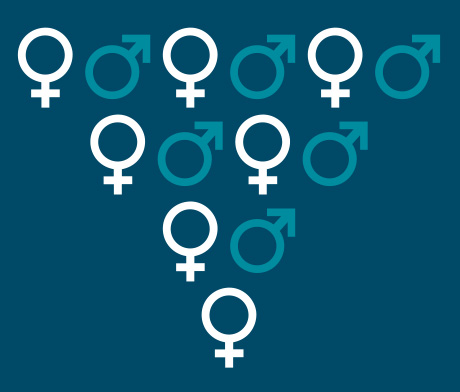STDs
We inform, you decide.
1 in 5 people in the US have an STD.1
-Centers for Disease Control

Gonorrhea & Chlamydia Pelvic Inflammatory Disease Treatment
Gonorrhea
Gonorrhea2 is a sexually transmitted disease caused by Neisseria gonorrhoeae, a bacterium that can grow and multiply in warm, moist areas of the reproductive tract in women and men. It can cause infections in the genitals, rectum and throat.
- Many women and men have no symptoms of Gonorrhea.
- Symptoms can take up to 30 days to appear.
- Symptoms of Gonorrhea in women include:
- Painful or burning sensation when urinating
- Increased vaginal discharge
- Vaginal bleeding between menstrual periods
Pelvic Inflammatory Disease
Pelvic Inflammatory Disease (PID)9 is an infection of a woman’s reproductive organs. It is a complication often caused by STDs like chlamydia and gonorrhea.
- PID risk is highest among sexually active women, particularly those with multiple partners or a history of STDs.
- Symptoms of PID include:
- Lower abdominal pain
- Fever
- Unusual vaginal discharge
- Pain and/or bleeding during intercourse
- Burning sensation during urination
- Bleeding between periods
PID can be cured if it is diagnosed and treated early. However, treatment cannot undo damage to your reproductive system. The longer you wait to get treated, the more likely it is that you will have complications from PID.
PID is the most common complication following an abortion in women who have untreated chlamydia and/or gonorrhea.10
Chlamydia
Chlamydia4 is a common sexually transmitted disease caused by the bacterium Chlamydia trachomatis which can cause serious, permanent damage to the woman’s reproductive system. Chlamydia is the most prevalent STD.
- Use of hormonal contraceptives increases the risk of contracting chlamydia.4
- Symptoms can take several weeks to appear after exposure.
- Chlamydia trachomatis has been linked to 30-50% of all ectopic pregnancies.5
- The most common symptoms of Chlamydia in women include:
- Abnormal vaginal discharge
- Burning sensation upon urination
- Lower abdominal pain
- Low back pain
- Painful intercourse
Chlamydia is a dangerous infection which often has no symptoms. Most people who have chlamydia do not realize they have it.4

- Do not have sex during treatment of an STD.
- Notify all sex partners that you have an STD so they can be tested and treated.
- Women whose partners have not been properly treated are at a high risk for re-infection. Multiple infections of Chlamydia increase the risk of other serious complications.
- You should be tested for STDs 3-4 months after finishing treatment regardless of whether you believe your sex partner(s) were successfully treated.
“The most reliable way to avoid transmission of STDs is to abstain from oral, vaginal, and anal sex or to be in a long-term, mutually monogamous relationship with a partner known to be uninfected.”8
-Centers for Disease Control
Sources
- Centers for Disease Control and Prevention (2021). STI Incidence/Prevalence Estimates. Retrieved June 2021 from https://www.cdc.gov/nchhstp/newsroom/2021/ 2018-STI-incidence-prevalence-estimates-press-release.html.
- Centers for Disease Control and Prevention (2021). Gonorrhea: Basic Fact Sheet. Retrieved June 2021 from https://www.cdc.gov/std/gonorrhea/stdfact-gonorrhea.htm.
- Centers for Disease Control and Prevention (2021). CDC estimate 1 in 5 people in the U.S. have a sexually transmitted infection. Retrieved June 2021 from https://www.cdc.gov/media/releases/2021/p0125-sexualy-transmitted-infection.html.
- Centers for Disease Control and Prevention (2021). Chlamydia: Fact Sheet. Retrieved June 2021 from https://www.cdc.gov/std/chlamydia/.
- Nethra, H. S., Praneetha, K., Sreelatha, S., Bhairi, S.S., (2018). A study on risk factors and clinical presentation of ectopic pregnancy. The New Indian Journal of OBGYN; 4(2): 146-149.
- Centers for Disease Control and Prevention (2021). Chlamydia: Treatment and Care. Retrieved June 2021 from https://www.cdc.gov/std/chlamydia/treatment.htm.
- Westergaard, L., Philipsen, T., Scheibel, J., (1982). Significance of cervical Chlamydia trachomatis infection in postabortal pelvic inflammatory disease. Obstet Gynecol; 60(3): 322-325.
- Centers for Disease Control and Prevention (2015). Sexually transmitted diseases treatment guidelines 2015. MMWR; 64(No.RR-3): 1-137.
- Centers for Disease Control and Prevention (2021). Pelvic Inflammatory Disease (PID) – CDC Fact Sheet. Retrieved June 2021 from https://www.cdc.gov/std/pid/stdfact-pid.htm.
- Stevenson, M.M., Radcliffe, K.W. (1995) Preventing pelvic infection after abortion. Int J STD AIDS; 6(5): 305-312.